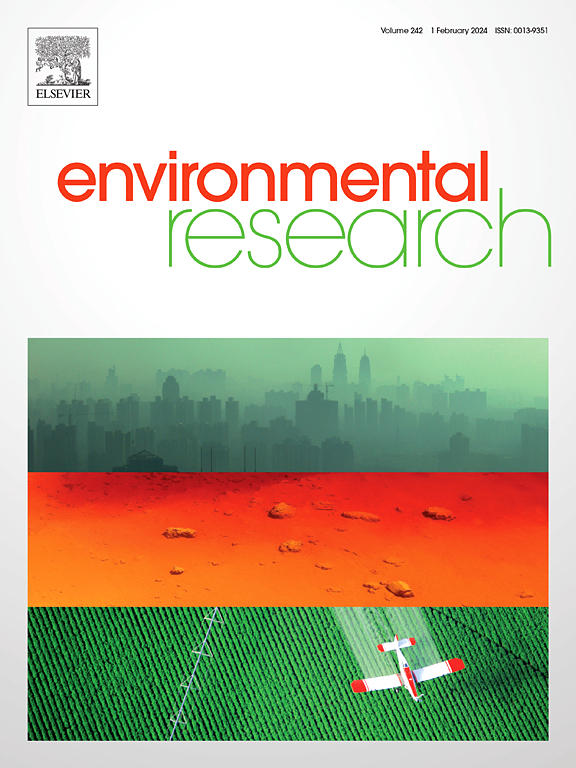具有pH自调节的耐酸铁泥基粉煤灰地聚合物泡沫高效除砷
IF 7.7
2区 环境科学与生态学
Q1 ENVIRONMENTAL SCIENCES
引用次数: 0
摘要
酸性含砷废水具有高毒性和环境风险,需要高效的处理技术。本研究将粉煤灰基地聚合物泡沫作为载体与含铁污泥结合,开发了一种新型吸附剂(含铁污泥基粉煤灰地聚合物泡沫),旨在协同增强酸性条件下砷的吸附性能和pH的自我调节。通过调整铁泥掺量,优化多孔结构和力学性能,确定粉煤灰与铁泥的最佳配比为4:1。表征分析表明,氧化铁作为纳米颗粒均匀地分散在二氧化硅-氧化铝基体中,形成丰富的三坐标铁羟基(≡Fe-OH)作为活性位点,并具有梯度孔结构。吸附等温线符合Sips模型,拟合吸附量为77±9 mg/g,在初始As(V)浓度为C0 = 1 g/L、初始pH为2.5、投加率为0.6 g/L的条件下,砷的去除率为98.34%。吸附过程遵循准二级动力学模型,以配位相互作用为主,铁羟基与砷之间的化学键有效克服了酸性条件下表面质子化抑制。吸附-解吸循环实验证实了该材料具有良好的再生能力(5次循环后去除率达95%)。动态柱实验表明,该材料可连续处理2340床体积的废水,出水砷浓度保持在10 μg/L以下。为提高系统的pH调节性能,提出了双柱串联工艺优化方案。本研究为工业固体废物资源化利用和酸性废水“废转废”处理提供了理论支持和技术途径。本文章由计算机程序翻译,如有差异,请以英文原文为准。

Acid-resistant iron sludge-based fly ash geopolymer foam for efficient arsenic removal with pH self-regulation
Acidic arsenic-containing wastewater requires efficient treatment technologies due to its high toxicity and environmental risks. This study developed a novel adsorbent (Iron Sludge-Based Fly Ash Geopolymer Foam) by combining fly ash-based geopolymer foam as a carrier with iron-containing sludge, aiming to synergistically enhance arsenic adsorption performance and pH self-regulation under acidic conditions. By adjusting the iron sludge content to optimize the porous structure and mechanical properties, the optimal fly ash/iron sludge ratio was determined to be 4:1. Characterization analysis revealed that iron oxides were uniformly dispersed as nanoparticles within the silica-alumina matrix, forming abundant three-coordinate iron hydroxyl groups (≡Fe-OH) as active sites along with a gradient pore structure. The adsorption isotherm conformed to the Sips model with a fitted adsorption capacity of 77 ± 9 mg/g and achieved 98.34 % arsenic removal at an initial concentration of As(V) of C0 = 1 g/L, the initial pH of 2.5, and a dosing rate of 0.6 g/L. The adsorption process followed a pseudo-second-order kinetic model, dominated by coordination interactions, where the chemical bonding between iron hydroxyl groups and arsenic effectively overcame the surface protonation inhibition under acidic conditions. Adsorption-desorption cycle experiments confirmed the material's excellent regeneration ability (removal efficiency >95 % after five cycles). Dynamic column experiments demonstrated that the material could continuously treat 2340 bed volumes of wastewater while maintaining an effluent arsenic concentration below 10 μg/L. A dual-column series process optimization was proposed to enhance the system's pH regulation performance. This study provides theoretical support and a technical pathway for the resource utilization of industrial solid waste and the "waste-to-treat-waste" approach for acidic wastewater treatment.
求助全文
通过发布文献求助,成功后即可免费获取论文全文。
去求助
来源期刊

Environmental Research
环境科学-公共卫生、环境卫生与职业卫生
CiteScore
12.60
自引率
8.40%
发文量
2480
审稿时长
4.7 months
期刊介绍:
The Environmental Research journal presents a broad range of interdisciplinary research, focused on addressing worldwide environmental concerns and featuring innovative findings. Our publication strives to explore relevant anthropogenic issues across various environmental sectors, showcasing practical applications in real-life settings.
 求助内容:
求助内容: 应助结果提醒方式:
应助结果提醒方式:


